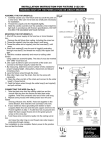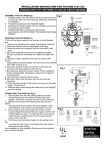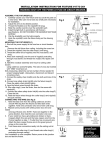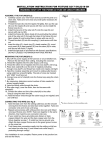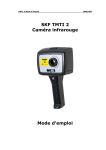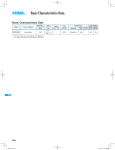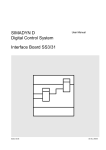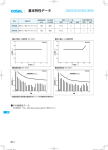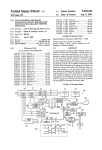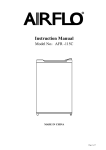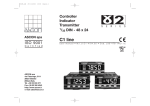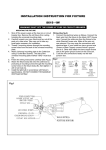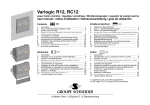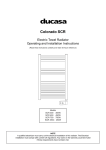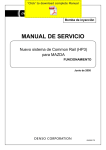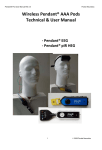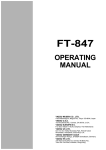Download Basic Characteristics Data
Transcript
Basic Characteristics Data Basic Characteristics Data Model Circuit method Switching frequency [kHz] Inrush current protection Material Single sided DPG500 Active filter 130 SCR Aluminum DPG750 Active filter 130 SCR Aluminum DPG DPG-4 Series/Parallel operation availability PCB/Pattern Double sided Series operation Parallel operation Yes No No Yes No No AC-DC Power Supplies Bus Converter . Power Module Type Instruction Manual 1 Pin Connection DPG-6 2 Input Voltage Derating DPG-6 3 Standard Connection Method DPG-6 4 5 6 3.1 Standard connection method DPG-6 3.2 External components DPG-6 3.3 Wiring input pin DPG-7 3.4 Connection of loaded circuit DPG-7 3.5 Heatsink DPG-7 Function DPG-7 4.1 Overcurrent protection DPG-7 4.2 Overvoltage protection DPG-7 4.3 Thermal protection DPG-7 4.4 Auxiliary power supply circuit for external signal (AUX) DPG-7 4.5 Enable signal (ENA) DPG-8 4.6 Isolation DPG-8 Series and Parallel Operation DPG-8 5.1 Series operation DPG-8 5.2 Parallel operation DPG-8 Implementation-Mounting Method DPG-8 6.1 Mounting method DPG-8 6.2 Stress onto the pins DPG-8 6.3 Cleaning DPG-8 6.4 Soldering DPG-8 6.5 Derating DPG-9 DPG-5 DPG AC-DC Power Supplies Bus Converter . Power Module Type 1 Pin Connection Instruction Manual 3 Standard Connection Method AUX6 7ENA 3.1 Standard connection method 1AC1 5-Vout 2AC2 4+Vout ¡To use DPG Series, connection shown in Fig.3.1 and outside attached components are required. Through this connection, DC output voltage can be obtained from AC input voltage. AC input voltage and DC output voltage are not insulated. 3R Heatsink DPG series F1 Noise AC IN Filter *Bottom View FG C1 Pin Connection AC1 AC2 R +VOUT -VOUT AUX ENA FG F2 R2 DBS/DHS series LF1 C2 C3 C5 PC1 +VIN -VIN RC1 ENA C4 Fig.3.1 Standard connection method AC Input External resistor for inrush current protection +DC output -DC output Auxiliary power supply for external signal Enable signal Table 3.1 External components No. Symbol ¡Fig.2.1 and 2.2 shows rated output for each input voltage section. Maximum output should be within this range. Output power [W] R1 TH1 Function 2 Input Voltage Derating Component Required characteristics F1 Input fuse 15A or less Slow-blow type F2 Output fuse 10A or less Normal-blow type C1 Input capacitor 2 F or more, Rated ripple current : 5 9A or more, Film capacitor, Safety approved type C2 Output capacitor 1 F or more, Rated ripple current : 4 8A or more, Film capacitor C3 Holdup capacitor 220 - 2200 F Aluminum electrolytic capacitor C4 Y-capacitor 2200pF Safety approved type R1 Inrush cuurent protection resistor 4.7 - 22 Wirewound Resistor with Thermal Cut-Offs 500 3.2 External components 300 F1 85 90 95 170 Input fuse : 15A or less Fuse is not built-in at input side. In order to secure the safety, Input Voltage [AC V] use the slow-blow type fuse F1 (15A or less). Fig.2.1 Input voltage derating curve (DPG500) F2 Output power [W] DPG -VOUT AUX AC2 Table 1.1 Pin Connection and function No. 1 2 3 4 5 6 7 R +VOUT AC1 Output fuse : 10A or less Since over current protection is not built-in, use the normal- 750 blow type fuse F2 (10A or less) at output side to secure the safety. 500 C1 Input capacitor : 2mF or more Install an external capacitor C1 (2mF or more) to keep stable 85 90 95 170 Input Voltage [AC V] Fig.2.2 Input voltage derating curve (DPG750) DPG-6 operation and to avoid failure. Use AC250V rated voltage with safety approved and over 5A rated ripple current. AC-DC Power Supplies Bus Converter . Power Module Type C2 Output capacitor : 1mF or more Install an external capacitor C2 (1mF or more) as close as Instruction Manual 3.5 Heatsink possible to the output pins to keep stable operation and to ¡The power supply adopts the conduction cooling system. Attach a avoid failure. Use DC400V or higher rated voltage and over heatsink to the aluminum base plate to cool the power supply for 4A rated ripple current capacitor. use. If the ambient temperature is below -20C, Holdup capacitors Refer to 6.5 Derating. ESR increases remarkably. Cr must connect 4mF or more. C3 Holdup capacitor : 220-2200mF Since holdup capacitor is not built-in, install electrolytic 4 Function capacitor C3 (220 - 2200mF) close to the ouput pins. The rated ripple current of C3 and the holdup time for module should be considered. The capacitor value should be within 220 to 2200mF to avoid failure. 4.1 Overcurrent protection ¡The overcurrent protection circuit is not built-in. If the ambient temperature is below -20C, Holdup capacitors ESR increases remarkably. Therefore, be sure to verify characteristics by actual evaluation. C4 4.2 Overvoltage protection ¡The overvoltage protection circuit is built-in. The AC input should be shut down if overvoltage protection is in operation. Y-capacitor : 2200pF When this function operates, the power factor corrector function Install an external capacitor C4 (2200pF) to keep stable does not operate, and output voltage becomes the full-wave recti- operation. Use AC250V rated voltage with safety approved fied AC input voltage. capacitor. Remarks: R1 Inrush current protection resistor : 4.7 - 22W Please note that the unit’s internal components may be damaged Connect a resistor between R pin and +Vout pin for inrush if excessive voltage (over rated voltage) is applied to output termi- current protection. The surge capacity is required for R1, nal of power supply. This could happen when the customer tests please contact component mfg. Wirewound resistor with the overvoltage performance of the unit. thermal cut-offs type is required. 4.3 Thermal protection 3.3 Wiring input pin ¡A noise filter is not built in this power supply. Connect an external noise filter to reduce the conducted noise to the power supply line. ¡Thermal protection circuit is built-in and it operates about 115C. If this function comes into effect, shut down the output, eliminate all possible causes of overheating, and drop the temperature to ¡A fuse to protect input is not built in. To assure safety, install a slow-blow fuse of 15A maximum to the input circuit F1. normal level. To prevent the unit from overheating, avoid using the 3.4 Connection of loaded circuit does not operate, and output voltage becomes the full-wave recti- unit in a dusty, poorly ventilated environment. When this function operates, the power factor corrector function ¡For connecting the DBS/DHS series, see Fig.3.1. For details of F2, LF1 and C5, refer to the instruction manual for the DBS/DHS series. LF1 may not be required, depending on the noise standard or the design of the printed circuit board. In this case, ENA and RC1can be directly connected, without having PC1. ¡Control load current so that it may flow only when the terminal ENA is at "L" . At "H" when inrush current protection circuit is not fied AC input voltage and ENA output changes into "H". 4.4 Auxiliary power supply circuit for external signal (AUX) ¡Shortprotection resistance (2.2kW) is built in. Outout voltage decreases as the output current increases. ¡Never let a short circuit occur between the AUX pin and other pins. It may damage the unit. released, excessive current may be applied to the circuit. 2.2kW ¡For connection of loads except the series DBS/DHS, please contact Cosel development department. AUX 12V -VOUT Fig.4.1 AUX circuit DPG-7 DPG AC-DC Power Supplies Bus Converter . Power Module Type 4.5 Enable signal (ENA) ¡Use ENA to control starting of the loaded power supply. ¡When inrush current protection circuit is released, ENA outputs “LOW” . ¡If load current flows without releasing of the circuit, the resistor may be burnt. No. 1 2 3 4 5 6 Table 4.1 Specification of TMP, IOG Item ENA Outout passible "L" Function Outout prohibited "H" Base pin -VOUT Level voltage "L" 0.6V max at 10mA Level voltage "H" Open drain Maxmum sink current 10mA max Maxmum applied voltage 35V max 4.6 Isolation ¡For a receiving inspection, such as Hi-Pot test, gradually increase (decrease) the voltage for a start (shut down). Avoid using Hi-Pot Instruction Manual ¡Avoid placing the AC input line pattern lay out underneath the unit, it will increase the line conducted noise. Make sure to leave an ample distance between the line pattern lay out and the unit. Also avoid placing the DC output line pattern of DC-DC converter underneath the unit because it may increase the output noise. Lay out the pattern away from the unit. ¡High-frequency noise radiates directly from the unit to the atmosphere. Therefore, design the shield pattern on the printed circuit board and connect its one to FG. The shield pattern prevents noise radiation. 6.2 Stress onto the pins ¡When too much stress is applied to the pins of the power supply, the internal connection may be weakened. As shown in Fig.6.1 avoid applying stress of more than 19.6N (2kgf) on the pins. ¡The pins are soldered on PCB internally, therefore, do not pull or bend them with abnormal forces. ¡Fix the unit on PCB(fixing fittings) to reduce the stress onto the pins. tester with the timer because it may generate voltage a few times higher than the applied voltage, at ON/OFF of a timer. 5 Series and Parallel Operation Less than 19.6N Less than 19.6N Less than 19.6N 5.1 Series operation Fig.6.1 Stress onto the pins ¡As input and output are not insulated, series operation is impossible DPG 5.2 Parallel operation ¡Parallel operation is not possible. 6.3 Cleaning ¡Clean the product with a brush. Prevent liquid from getting into the product. Do not soak the product into liquid. ¡Do not stick solvent to a name plate or a resin case. (If solvent sticks to a name plate or a resin case, it will cause 6 ImplementationMounting Method to change the color of the case or to fade letters on name plate away.) ¡After cleaning, dry them enough. 6.4 Soldering 6.1 Mounting method ¡The unit can be mounted in any direction. When two or more power supplies are used side by side, position them with proper intervals to allow enough air ventilation. Aluminum base plate temperature around each power supply should not exceed the temperature range shown in derating curve. DPG-8 ¡Flow soldering: 260C less than 15 seconds. ¡Soldering iron : 450C less than 5 seconds. AC-DC Power Supplies Bus Converter . Power Module Type Instruction Manual 6.5 Derating ¡Use with the conduction cooling (e.g. heat radiation by conduction from the aluminum base plate to the attached heat sink). Fig.6.2 shows the derating curve based on the aluminum base plate temperature. In the hatched area, the specification of Ripple and Ripple Noise is different from other areas. ¡Please measure the temperature on the aluminum base plate edge side when you cannot measure the temperature of the center part of the aluminum base plate. In this case, please take 5deg temperature margin from the derating characteristic of Fig 6.2. ¡It is necessary to note the thermal fatigue life by power cycle. Please reduce the temperature fluctuation range as much as possible when the up and down of the temperature are frequently generated. Contact us for more information on cooling methods. Load factor [%] 100 1 80 2 1 DPG500 2 DPG750 60 40 20 0 -40 -20 0 20 40 60 80 100 Aluminum base plate temperature Tc [C] 120 Tc Measuring point DPG Baseplate Fig.6.2 Derating curve DPG-9







